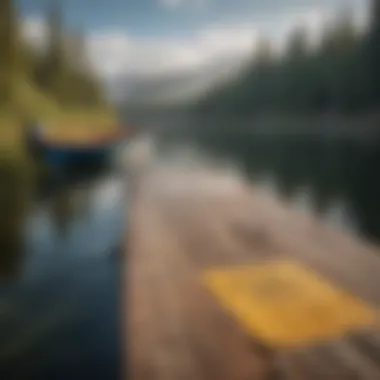Exploring Boating in Colorado: A Comprehensive Guide


Intro
Boating in Colorado provides a unique lens through which to explore the state's rich natural beauty and recreational opportunities. The state is home to numerous lakes, rivers, and reservoirs, ideal for various boating activities, from kayaking to sailing. As boating gains popularity, understanding the essential components of this experience becomes crucial. By examining waterways, regulations, safety practices, and sustainable approaches, we can appreciate the multifaceted nature of boating in this picturesque region.
Key Points
In embarking on this exploration, several aspects warrant attention:
- Waterways: A detailed overview of Colorado's major lakes and rivers for boating.
- Safety: Essential tips and regulations to ensure a safe boating experience.
- Sustainability: The importance of maintaining aquatic ecosystems while enjoying recreational activities.
- Community Insights: Engaging with local boating communities and their stewardship practices.
This article serves as a comprehensive guide that not only celebrates the thrill of boating but also promotes responsible enjoyment of these natural resources.
Foreword to Boating in Colorado
Boating in Colorado presents a unique intersection of natural beauty and recreational opportunity. The state's stunning landscapes, from majestic mountains to serene lakes, provide ideal environments for various boating activities. Understanding the significance of boating in Colorado is important for both residents and visitors. It fosters an appreciation of the outdoors and offers an accessible means to engage with the state’s rich natural resources.
The importance of this topic extends beyond mere recreation. Boating can enhance physical well-being, allowing individuals to connect with nature while participating in activities like fishing, kayaking, or sailing. This engagement with the outdoors can lead to heightened awareness of environmental issues affecting aquatic ecosystems. As such, it is vital to consider sustainable practices that can minimize the impact of boating on these ecosystems.
Moreover, the boating community in Colorado plays a crucial role in the local economy. From rental businesses to repair shops, various sectors depend on tourism and local boating activities, which can generate significant revenue. By supporting boating initiatives, individuals contribute to the preservation of both natural habitats and local livelihoods.
Overview of Colorado's Waterways
Understanding Colorado's waterways is vital for anyone interested in boating in this diverse region. The state's rivers and lakes are not only essential for recreational activities but they also play a crucial role in the environment. These waterways provide habitats for wildlife, enhance local economies, and offer countless opportunities for outdoor enthusiasts.
Rivers and Lakes
Colorado is home to numerous rivers and lakes that cater to various boating activities. The rivers, such as the Arkansas and Colorado River, are famous for their swift currents and stunning scenery. These rivers provide thrilling experiences for kayaking and white-water rafting. The lakes, on the other hand, like Cherry Creek Reservoir and Blue Mesa Reservoir, are more suited for leisurely activities such as pontoons and fishing. Understanding the features of different waterways allows individuals to choose the right environment for their preferred boating experience.
Notable Boating Sites
Lake Powell
Lake Powell is one of the most recognized water-based recreational areas in Colorado. Its vibrant blue waters contrast sharply with red rock formations, making it visually striking. This site is beneficial for various activities like water skiing and house boating. One of the unique features of Lake Powell is its vastness; it spans over 186 miles and offers over 96 major canyons for exploration. Its expansive size can, however, lead to challenges such as the risk of getting lost or difficult weather conditions.
Cherry Creek Reservoir
Cherry Creek Reservoir is known for its accessibility and well-maintained facilities. It serves as a popular spot for both casual boaters and serious enthusiasts. The key characteristic of this location is its convenient access to the Denver metro area, making it a quick getaway for many. The reservoir features ample shoreline, which is ideal for picnics and water activities. However, its popularity means that it can become crowded, especially during weekends and holidays.
Blue Mesa Reservoir
Blue Mesa Reservoir stands out due to its sheer size, being the largest body of water in Colorado. It is a prime location for both recreational boating and fishing, especially for those looking to catch kokanee salmon. The scenic backdrop of the surrounding mountains provides breathtaking views and enhances the overall experience. But, potential visitors should be aware that its remote location can make access challenging during winter months when roads may be closed due to snow.
"Exploring Colorado’s waterways is not just about the thrill of the ride, but about appreciating the natural beauty and the ecosystems that these bodies of water support."
Each of these notable sites contributes significantly to the boating culture in Colorado. By exploring these waterways, boaters can maximize their enjoyment while also understanding the importance of preserving these natural resources.
Types of Boating Activities
Boating in Colorado offers a variety of activities, each catering to different preferences and experiences. Recognizing these activities is essential for enthusiasts and newcomers alike, as they shape the overall experience on the water. Understanding the distinct elements of each type can enhance enjoyment and inform choices when planning outings.
Recreational Boating
Recreational boating encompasses a broad range of activities designed for pleasure and leisure. This type of boating is often characterized by family outings, gatherings with friends, and general enjoyment of Colorado's beautiful waterways.


Recreational boating can involve various types of vessels, including motorboats or pontoons. This offers flexibility in how one wishes to explore local lakes and rivers. Social interaction plays a significant role in these experiences, as many use opportunities on the water to bond with family and friends.
It is also an avenue to appreciate the stunning landscape of Colorado. With opportunities for relaxation, opportunities for fun activities, and the thrill of speed, recreational boating contributes significantly to local tourism and outdoor culture.
Fishing
Fishing is not just an activity; it embodies a way of life for many in Colorado. The state's diverse aquatic ecosystems provide ideal conditions for both casual and avid anglers. Understanding the best times and locations for fishing enhances the chances of a successful outing.
Common fish species include trout, bass, and catfish. Each fish requires specific gear, techniques, and knowledge about local regulations. Anglers often share their experiences in local forums to discuss strategies and tips, creating a sense of community.
Furthermore, fishing promotes responsible stewardship of aquatic environments. Adhering to regulations helps preserve fish populations and habitats. This sustainable approach to fishing can ensure that future generations can enjoy these natural resources.
Sailing
Sailing introduces a unique aspect to boating, distinguished by its dependency on wind rather than engine power. It requires specific skills but rewards sailors with a distinct sense of accomplishment and freedom on the water. Colorado's lakes and rivers provide suitable conditions for both novice and experienced sailors.
Sailing can be meditative, allowing individuals to connect with nature while honing seamanship skills. Many clubs offer lessons and organized outings, promoting camaraderie among participants. Sailboats vary in size and function, accommodating different levels of experience and preferences.
Availability of sailing events connected with local sailing clubs can enhance engagement and skill development in this activity.
Kayaking and Canoeing
Kayaking and canoeing represent closer ties to nature. These activities allow participants to navigate waterways with a hands-on experience. Rivers and lakes provide various currents and conditions to challenge paddlers of all levels.
Kayaking often appeals to those seeking adventure, particularly in white-water conditions. In contrast, canoeing offers a more leisurely pace, ideal for enjoying serene landscapes and quiet conversation.
Both activities require minimal equipment, which makes them accessible. Local rental shops provide necessary gear, encouraging participation without the need for significant investment. Joining local clubs enhances experiences through shared outings and learning sessions, promoting skills and safety.
Some resources exist for further exploration:
In summary, understanding each type of boating activity helps enthusiasts identify which experiences will be most fulfilling. By exploring the various options, individuals can engage with Colorado's waterways in a way that resonates with them.
Environmental Considerations
Understanding environmental considerations is essential for anyone engaging in boating activities in Colorado. The impact of recreational activities on natural ecosystems can be significant. As we explore the vast waterways of Colorado, it is vital to assess how boating affects aquatic ecosystems and to adopt sustainable practices that preserve these precious environments.
Impact on Aquatic Ecosystems
Boating can have multiple effects on aquatic ecosystems. The alteration of water quality and habitat is one main concern. Powerboats, jet skis, and large vessels create wake turbulence, which can erode shorelines and disturb aquatic habitats. This disruption can have detrimental effects on fish populations and plant life. Moreover, chemical pollutants from boats can leach into the water, affecting the overall health of aquatic organisms.
"The integrity of aquatic ecosystems relies on responsible boating practices and environmental stewardship."
Another important point is the introduction of invasive species. Boats that travel between different bodies of water can unintentionally transport non-native species. These invasive species often outcompete local flora and fauna, leading to diminished biodiversity. It's crucial for boaters to thoroughly clean and inspect their vessels before moving to a new waterway to minimize this risk.
Sustainable Boating Practices
Sustainable boating practices are fundamental for protecting Colorado's waterways. Using eco-friendly products is one way to mitigate environmental impact. For instance, choosing biodegradable cleaning supplies helps reduce chemical runoff into rivers and lakes. Additionally, opting for low-emission engines when possible can contribute to cleaner air and water.
Boaters should also be mindful of waterway conditions. Observing no-wake zones helps maintain the equilibrium of the ecosystem while preventing unnecessary sediment disturbance. When possible, it is wise to anchor only in designated areas so as not to damage the aquatic plants and wildlife.
Here are some sustainable practices boaters can follow:
- Clean your boat regularly to remove pollutants and invasive species
- Use biodegradable products for cleaning and maintenance
- Follow local regulations about speed limits and no-wake zones
- Participate in local clean-up events to help maintain the beauty of waterways
- Educate others about the importance of sustainable activities on the water


By actively embracing sustainable practices, boaters ensure that aquatic ecosystems remain robust for future generations. This allows everyone to enjoy the unique waterways Colorado has to offer while safeguarding these environments from unnecessary harm.
Boating Regulations in Colorado
Understanding boating regulations in Colorado is crucial for anyone looking to engage in recreational boating activities. These regulations not only ensure the safety of individuals on the water but also help protect the environment and aquatic ecosystems. Compliance with these rules can prevent accidents and legal complications, making boating more enjoyable and secure for everyone involved.
Licensing Requirements
In Colorado, a boat operator aged 16 years and older must possess a valid Colorado boating license if they are operating a motorized vessel. The process to obtain this license involves completing an approved boating safety course. These courses cover essential topics such as navigation rules, safety procedures, and regulations pertaining to local waterways. Notably, licenses must be renewed periodically, emphasizing the importance of staying updated with ongoing education in boating safety.
Important Note:
Failure to have the proper licensing can result in fines and penalties, underscoring the necessity of adhering to state regulations.
Moreover, different types of vessels may have additional licensing requirements. For instance, personal watercraft, often referred to as jet skis, may require specific safety courses tailored to their operation. Checking local guidelines is vital before heading out on the water.
Safety Regulations
Safety regulations are fundamental aspects of boating in Colorado. These guidelines exist to protect both boaters and the surrounding environment. All vessels must be equipped with essential safety gear, including personal flotation devices (PFDs), fire extinguishers, and navigation lights, depending on the type of vessel and the waters being navigated. For example, boats must have PFDs for each passenger on board, and non-motorized vessels must carry a PFD for each individual, ensuring that everyone can remain safe in the event of an emergency.
In addition to gear requirements, Colorado places a strong emphasis on the management of boating under the influence (BUI). Regulations stipulate that operating a vessel with a blood alcohol concentration (BAC) of 0.08% or higher is illegal, similar to laws for motor vehicles. Such measures are crucial in reducing accidents on the water, enhancing overall safety for all participants.
The enforcement of speed limits and no-wake zones in certain waterways further demonstrates Colorado's commitment to maintaining safe boating conditions. These regulations help protect aquatic life and ensure the waterways are navigable for all users. Understanding and complying with these regulations is not only a legal responsibility but also a moral one, as they contribute to the safety and enjoyment of recreational boating experiences in Colorado.
Safety Tips for Boaters
Boating is an enjoyable activity that attracts many people. However, it is essential to prioritize safety to ensure a pleasant experience on Colorado's waters. In this section, we explore various safety tips that all boaters should adhere to. The right preparation and mindset can reduce risks significantly and make boating a more secure and enjoyable activity.
Essential Safety Gear
Having the correct safety gear is non-negotiable for any boating adventure. Here are some critical items that should always be on board:
- Personal Floatation Devices (PFDs): All boaters must wear PFDs. These devices are designed to help keep individuals afloat in case they fall overboard.
- Fire Extinguisher: A U.S. Coast Guard-approved fire extinguisher is essential. Different types of boats have specific requirements, so ensure compliance with local laws.
- First Aid Kit: Injuries can happen. Prepare with a well-stocked first aid kit to handle minor emergencies.
- Emergency Signaling Devices: Flares or whistles can attract attention if you need rescue. Having visual or auditory signaling devices is crucial in emergencies.
- Navigation Lights: If you are boating after dark, ensure your boat has proper lighting to be visible to others on the water.
Additionally, it is beneficial to carry tools and equipment that can aid in quick repairs. This can be helpful if unexpected issues arise during the outing.
Navigational Safety
Understanding the waters is vital for safe boating. Being aware of navigation rules and local conditions enhances safety significantly. Consider the following:
- Chart Reading: Familiarize yourself with navigational charts. Knowing water depths and hazards in your route can prevent accidents.
- Understand Right of Way: Different boats have different rights on the water. Understanding these rules can prevent collisions. For example, generally, larger vessels have the right of way over smaller ones.
- Weather Awareness: Always check the weather forecast before heading out. Sudden storms can turn a safe outing into a dangerous situation. Be prepared to return if conditions worsen.
- Use of Technology: Employ GPS systems or boating apps that track your location and provide navigational insights.
"Safe boating involves knowledge, preparation, and the right mindset. Always prioritize safety to ensure an enjoyable time on the water."
Choosing the Right Boat
Choosing the right boat is essential for anyone looking to make the most out of their boating experience in Colorado. The vast array of lakes and rivers means that different activities require different types of vessels. The right boat can enhance enjoyment, ensure safety, and improve performance in specific conditions.
First, consider the specific activity you plan to engage in. Each boating activity, whether it is fishing, sailing, or recreational cruising, may necessitate a unique type of boat. Additionally, understanding your skill level and comfort with the water will guide your decision.
Types of Boats for Different Activities
- Fishing Boats: For anglers, flat-bottomed boats such as Jon boats or bass boats are a common choice. These vessels allow easy access to calm waters in lakes like Cherry Creek Reservoir.
- Sailing Vessels: Sailboats come in various sizes and designs. Smaller dinghies are perfect for beginners, while larger keelboats offer stability for open waters like those found at Lake Powell.
- Recreational Boats: These include pontoon boats and bowriders, ideal for leisurely outings with family and friends. They are often used on larger lakes, providing comfort and fun.
- Kayaks and Canoes: For those seeking adventure, sit-on-top kayaks or traditional canoes are versatile and allow access to more remote waterway areas. Popular rivers in Colorado, such as the Arkansas, attract paddlers of all skill levels.
- Personal Watercraft: Jet skis and similar crafts are great for fast-paced enjoyment on larger bodies of water. However, they require proper handling and safety precautions.
Factors to Consider When Purchasing or Renting


When deciding if you should purchase or rent a boat, several factors come into play.
- Budget: Consider initial costs, maintenance, and operational expenses. Renting may be more economical for infrequent users.
- Purpose: Identify your main reasons for wanting a boat. If you plan to venture out often, purchasing may be more beneficial.
- Storage: Owning a boat requires a place for storage. Check local regulations and available facilities.
- Experience: Evaluate your own capabilities and knowledge about boating. If you're a novice, renting might provide a safer introductory experience while you learn.
- Local Availability: Research rental services and their offerings. Some locations may provide unique options based on your preferences.
"The right choice of boat can turn an average day on the water into an extraordinary adventure."
Boating Events and Community
Boating is not just an individual pursuit; it is also a part of a larger community in Colorado. Engaging in boating events fosters a sense of camaraderie among enthusiasts and provides opportunities for education, competition, and responsible stewardship of the waterways. These events serve as platforms for sharing knowledge, best practices, and experiences, which are fundamental in promoting sustainable boating. Furthermore, participating in community-driven activities encourages individuals of all ages to explore recreational opportunities, effectively bridging generations through shared experiences.
Annual Boating Festivals
Annual boating festivals in Colorado attract participants and spectators alike. These events often celebrate the state's robust boating culture and showcase various activities ranging from races to demonstrations. Notable festivals include the Colorado River Rafting Festival and the Originally Art Boat Parade, which provide unique experiences for attendees.
Key Elements of Annual Boating Festivals:
- Networking Opportunities: These festivals allow boater enthusiasts, local businesses, and organizations to connect, fostering relationships that can last beyond the event.
- Workshops and Educational Sessions: Many festivals include workshops on boating safety, sustainable practices, and equipment maintenance, ensuring that participants can learn while enjoying their time on the water.
- Family Fun Activities: Events typically feature family-friendly activities which help engage younger generations, instilling an early appreciation for boating and the environment.
- Local Vendors and Artisans: Expect to find local businesses showcasing their products, which supports the Colorado economy and promotes unique boating gear.
"Events like the Colorado River Rafting Festival not only provide thrills but also emphasize the importance of preserving our aquatic ecosystems and the communities surrounding them."
Boating Clubs and Organizations
Boating clubs and organizations play a crucial role in fostering community engagement and promoting safe boating practices. These groups often unite individuals with varied boating interests, offering an inclusive environment where everyone is welcome to share their passion for water activities.
Benefits of Joining Boating Clubs:
- Resource Sharing: Members can exchange valuable information regarding local boating regulations, safety practices, and environmental initiatives.
- Organized Activities: Clubs frequently organize group outings, races, and clean-up events, enhancing the social aspect of boating while also contributing to local environmental efforts.
- Mentorship Opportunities: Experienced boaters often provide guidance to newcomers within these groups, helping them acclimate to the boating lifestyle while ensuring safety and compliance.
- Advocacy and Representation: Many organizations advocate for boating rights and environmental protection, working with local authorities to ensure a sustainable future for Colorado's waterways.
- Engagement with Like-minded Individuals: Clubs offer a platform to connect with others who share a similar love for boating, strengthening community ties.
Resources for Boating Enthusiasts
Resources play a pivotal role in enhancing the boating experience in Colorado. With the diverse selection of water bodies and varying activities, having access to the right tools and information can significantly improve safety and enjoyment. These resources not only assist in navigation but also promote responsible boating practices. Understanding and utilizing local resources can help anglers, sailors, and recreational boaters navigate Colorado's extensive waterways safely and effectively.
Boating Maps and Navigation Tools
Having proper maps and navigation tools is essential for any successful boating expedition. Colorado boasts an intricate system of rivers, lakes, and reservoirs, which can be challenging to navigate without the right guidance. Topographic maps provide valuable details on water depth, currents, and hazards.
Some important resources include:
- USGS Topographic Maps: These maps are vital for understanding the geographical features of the area. They offer insights into trails and contours that are not always visible on standard maps.
- Local Boating Maps: Often available at marinas, local parks, or online, these maps highlight specific boating zones, launch sites, and points of interest. They can also provide insight into fishing spots.
- GPS Devices: Modern GPS tools, specifically designed for marine environments, are crucial for accurate location tracking on the water. They can assist in avoiding obstacles and marked hazards.
From reliable maps to advanced navigational technology, these tools empower boaters to enhance their aquatic experience, promoting not only adventure but also safety.
Websites and Apps for Boaters
The digital age has transformed how boaters access information. Many websites and mobile applications cater specifically to boating enthusiasts, providing a wealth of resources at their fingertips. These platforms can aid in everything from planning trips to learning about local conditions.
Some noteworthy resources include these:
- Weather Apps: Applications like Weather Underground or NOAA Weather provide real-time weather updates. Understanding weather patterns is essential for boating, as conditions can change rapidly, impacting safety.
- Fishing and Boating Forums: Websites like Reddit have communities where boaters share experiences and offer tips. Engaging with these communities can enhance knowledge of local laws, best practices, and recommendations for locations.
- Navigation Apps: Popular apps such as Navionics can help with chart plotting and identifying hazards. Integration with mobile devices allows for convenient, on-the-go navigation solutions.
Utilizing these resources can elevate the boating experience, ensuring informed decisions and safer outings.
Integrating these tools enables boaters to explore Colorado’s aquatic environments with confidence. Emphasizing the importance of continuous learning and adaptation will facilitate a more rewarding and enriching experience on the water.
Closure
The conclusion of this guide encapsulates the essence of boating in Colorado. As explored throughout the article, Colorado provides a diverse range of waterways, activities, and resources that cater to the varied interests of boating enthusiasts. Understanding these elements is crucial for fostering a responsible boating culture that can sustain Colorado's natural beauty and aquatic environments.
To begin with, appreciating Colorado’s geography and unique ecological conditions is key. The mountain ranges and various lakes create stunning backdrops for both recreational and competitive boating. Engaging with the local ecosystem also implies an understanding of how boating impacts wildlife and water quality. Thus, responsible stewardship remains a significant aspect that needs emphasis.
Boat regulation and safety measures are pivotal. They not only protect boaters but also ensure the preservation of natural habitats. Knowing the legal requirements and adhering to safety guidelines contributes to a safer boating experience for all. Furthermore, engaging with local clubs and participating in community events enhances social bonds among boaters, encouraging knowledge sharing and the promotion of sustainable practices.







